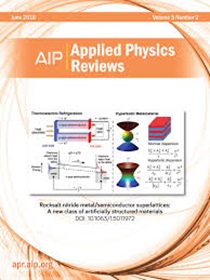Deep-reactive ion etching of silicon nanowire arrays at cryogenic temperatures
IF 11.9
1区 物理与天体物理
Q1 PHYSICS, APPLIED
引用次数: 0
Abstract
The pursuit of sculpting materials at increasingly smaller and deeper scales remains a persistent subject in the field of micro- and nanofabrication. Anisotropic deep-reactive ion etching of silicon at cryogenic temperatures (cryo-DRIE) was investigated for fabricating arrays of vertically aligned Si nanowires (NWs) of a large range of dimensions from micrometers down to 30 nm in diameter, combined with commonly used wafer-scale lithography techniques based on optical, electron-beam, nanoimprint, and nanosphere/colloidal masking. Large selectivity of ∼100 to 120 and almost 700 was found with resists and chromium hard masks, respectively. This remarkable selectivity enables the successful transfer of patterned geometries while preserving spatial resolution to a significant extent. Depending on the requirements by applications, various shapes, profiles, and aspect ratios were achieved by varying process parameters synchronously or asynchronously. High aspect ratios of up to 100 comparable to the best result by metal-assisted wet-chemical etching and sub-μm trenches by DRIE were obtained with NW diameter of 200 nm, at an etch rate of ∼4 μm/min without being collapsed. At the same time, low surface roughness values were maintained on the NW top, sidewall, and bottom surface of ∼0.3, ∼13, and ∼2 nm, respectively, as well as high pattern fidelity and integrity, which were measured using angle-resolved Fourier microscopy, combined atomic force, and scanning electron microscopy on selected NWs. This work establishes the foundation in the controllable development of Si nanoarchitectures, especially at sub-100 nm structures, for energy-harvesting and storage, damage-free optoelectronics, quantum, photovoltaics, and biomedical devices.在低温条件下对硅纳米线阵列进行深反应离子刻蚀
在越来越小和越来越深的尺度上雕刻材料仍然是微米和纳米制造领域的一个永恒主题。研究人员结合基于光学、电子束、纳米压印和纳米球/胶体掩模的常用晶圆级光刻技术,研究了在低温条件下对硅进行各向异性深反应离子刻蚀(低温-DRIE)以制造垂直排列的硅纳米线(NW)阵列的方法,这些纳米线的直径范围从微米到 30 纳米不等。在使用抗蚀剂和铬硬掩膜时,选择性分别达到 100 至 120 和近 700。这种显著的选择性使图案化几何形状的成功转移成为可能,同时在很大程度上保留了空间分辨率。根据不同的应用要求,通过同步或非同步改变工艺参数,可以获得各种形状、轮廓和纵横比。在蚀刻速率为 ∼4 μm/min 时,NW 直径为 200 nm,获得了高达 100 的高纵横比,与金属辅助湿化学蚀刻的最佳结果和 DRIE 的亚微米沟槽不相上下,且不会塌陷。同时,NW 的顶面、侧壁和底面保持了较低的表面粗糙度值,分别为 ∼0.3、∼13 和 ∼2 nm,而且图案的保真度和完整性也很高。这项工作为可控地开发硅纳米结构(尤其是 100 纳米以下结构)奠定了基础,可用于能量收集和存储、无损伤光电、量子、光伏和生物医学设备。
本文章由计算机程序翻译,如有差异,请以英文原文为准。
求助全文
约1分钟内获得全文
求助全文
来源期刊

Applied physics reviews
PHYSICS, APPLIED-
CiteScore
22.50
自引率
2.00%
发文量
113
审稿时长
2 months
期刊介绍:
Applied Physics Reviews (APR) is a journal featuring articles on critical topics in experimental or theoretical research in applied physics and applications of physics to other scientific and engineering branches. The publication includes two main types of articles:
Original Research: These articles report on high-quality, novel research studies that are of significant interest to the applied physics community.
Reviews: Review articles in APR can either be authoritative and comprehensive assessments of established areas of applied physics or short, timely reviews of recent advances in established fields or emerging areas of applied physics.
 求助内容:
求助内容: 应助结果提醒方式:
应助结果提醒方式:


